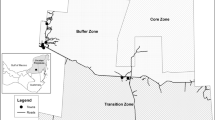Abstract
Background, aim, and scope
Human use of land areas leads to impacts on nature in several ways. Within the framework of the UNEP/SETAC Life Cycle Initiative, it was stated that life cycle assessment (LCA) of land use should assess at least the impact on biodiversity, the impact on biotic production, and the impact on the regulating functions of the natural environment. This study focuses on the climatic impact of land use as determined by the CO2 transfers between vegetation/soil and the atmosphere in the course of terrestrial release and re-storage of carbon.
Materials and methods
Compared with the potential natural vegetation as a baseline, areas getting transformed by man (land transformations) as well as areas forced to maintain their current non-natural state (land occupations) may store reduced amounts of carbon in soil and vegetation, whereby the mobilized carbon is essentially transferred to the atmosphere in form of CO2, contributing to global warming. The size of this climatic impact is determined by the amount of carbon transferred per hectare, as well as by the duration of the carbon’s stay in air. Generally, we consider this duration as limited by spontaneous reversal of vegetation and soil toward a quasi-natural form as soon as human land use ends. Taking the mean stay in air of 1 ton carbon from fossil fuel combustion as a basis of comparison, 1 ton carbon released by, e.g., a forest-to-cropland transformation can be adequately weighted by considering the timing of carbon backflow from air to the spontaneously regrowing forest.
Results
Carbon transfers to the air per hectare, as well as imputable durations of carbon stay in air, are determined for the most important types of land transformation and land occupation, for locations in any of the terrestrial biomes of tropical forest, temperate forest, boreal forest, tropical grassland, and temperate grassland. The carbon quantities are expressed as “fossil-combustion-equivalent” tons of carbon so that they can be summed up with carbon amounts from fossil fuel combustion into the usual LCA indicator for global warming potential.
Discussion
The results confirm that on a per hectare basis, transforming forests into cropland has a more serious climatic effect than continuing to occupy such land as cropland for one additional year. But on a global basis, maintaining current cropland areas for one additional year is a serious driver of global warming due to the huge area of croplands in zones where forest would be the natural vegetation. Furthermore, forest-to-cropland transformations cause carbon transfers to air per hectare of roughly similar size in tropical, temperate, or boreal zones, but due to slow forest restoration, transformation of boreal forests has a stronger influence on global warming.
Conclusions and recommendations
The results of this study facilitate a worldwide impact assessment of land use with respect to global warming. Together with the two separate studies covering the impacts of land use on biodiversity and on biotic production, a tool will be available for a reasonably complete LCA of land use at global level. However, the data quality needs further improvement.

Similar content being viewed by others
References
Alean J (2009) Morteratsch vegetation. Succession of vegetation in the glacier forefield. http://www.swisseduc.ch/glaciers/morteratsch/vegetation/index-en.html
Ceschi I (2006) Il bosco del cantone Ticino. Dipartimento del Territorio Cantone Ticino, Bellinzona CH
Fargione J, Hill J, Tilman D, Polasky S, Hawthorne P (2008) Land clearing and the biofuel carbon debt. Science 319:1235–1238
Frenzen P (2009) Mount St. Helens cfnv National Volcanic Monument, Vegetation Around the Volcano “Before and After the 1980 Eruption”. http://www.fs.fed.us/gpnf/mshnvm/digital-gallery/25yearsofrecoverybeforeandafter.htm
IPCC (2000) Land use, land-use change and forestry. IPCC Special Report, Cambridge University Press, Cambridge. http://www.grida.no/climate/ipcc/land_use/157.htm
IPCC (2001) Climate Change 2001, Working Group 1: The Scientific Basis, chapter 3, Carbon cycle. http://www.grida.no/climate/ipcc_tar/wg1/095.htm
IPCC (2007) IPCC Fourth Assessment Report, Working Group 1, Report “The Physical Science Basis. http://www.ipcc.ch/ipccreports/ar4-wg1.htm
Milà i Canals L, Bauer C, Depestele J, Dubreuil A, Freiermuth Knuchel R, Gaillard G, Michelsen O, Müller-Wenk R, Rydgren B (2007) Key elements in a framework for land use impact assessment within LCA. Int J Life Cycle Assess 12(1):5–15
Reijnders L, Huijbregts M (2008) Biogenic greenhouse gas emissions linked to the life cycles of biodiesel derived from European rapeseed and Brazilian soybeans. J Clean Prod 16:1943–1948
Searchinger T, Heimlich R, Houghton R, Dong F, Elobeid A, Fabiosa J, Tokgoz S, Hayes D, Yu T (2008) Use of U.S. croplands for biofuels increases greenhouse gases through emissions from land use change. Science 319:1238–1240
WBGU (1998) Die Anrechnung biologischer Quellen und Senken im Kyoto-Protokoll, Sondergutachten 1998. http://www.wbgu.de/wbgu_sn1998.pdf
Wild World (2009) Terrestrial ecoregions of the world. http://www.nationalgeographic.com/wildworld/terrestrial.html
Zah R, Boeni H, Gauch M, Hischier R, Lehmann M, Waeger P (2007) Life cycle assessment of energy productions—environmental assessment of energy productions. Executive Summary. http://www.bfe.admin.ch/dokumentation/energieforschung/index.html?lang=de&publication=9146
Author information
Authors and Affiliations
Corresponding author
Additional information
Responsible editor: Mark Huijgbregts
Rights and permissions
About this article
Cite this article
Müller-Wenk, R., Brandão, M. Climatic impact of land use in LCA—carbon transfers between vegetation/soil and air. Int J Life Cycle Assess 15, 172–182 (2010). https://doi.org/10.1007/s11367-009-0144-y
Received:
Accepted:
Published:
Issue Date:
DOI: https://doi.org/10.1007/s11367-009-0144-y




